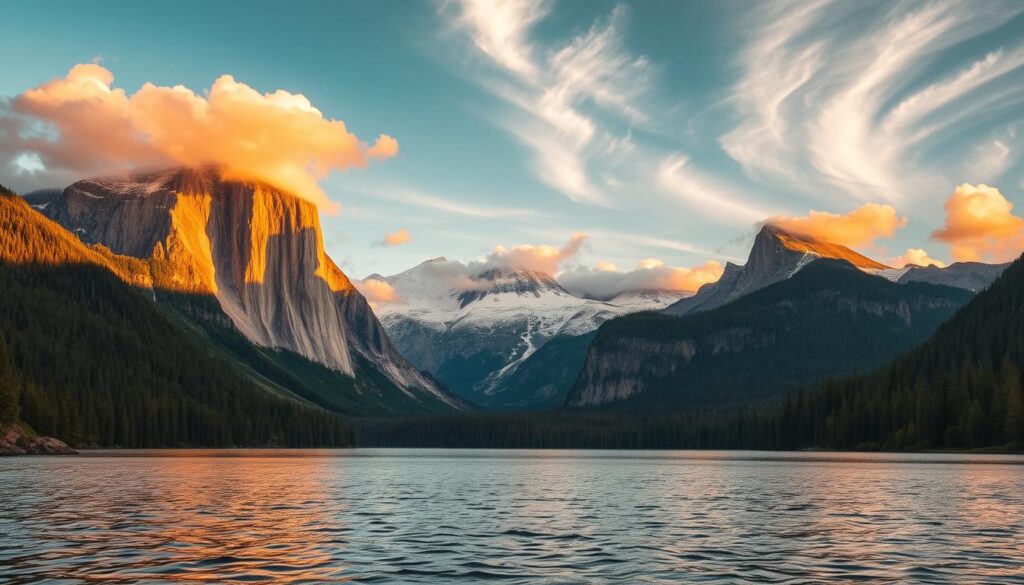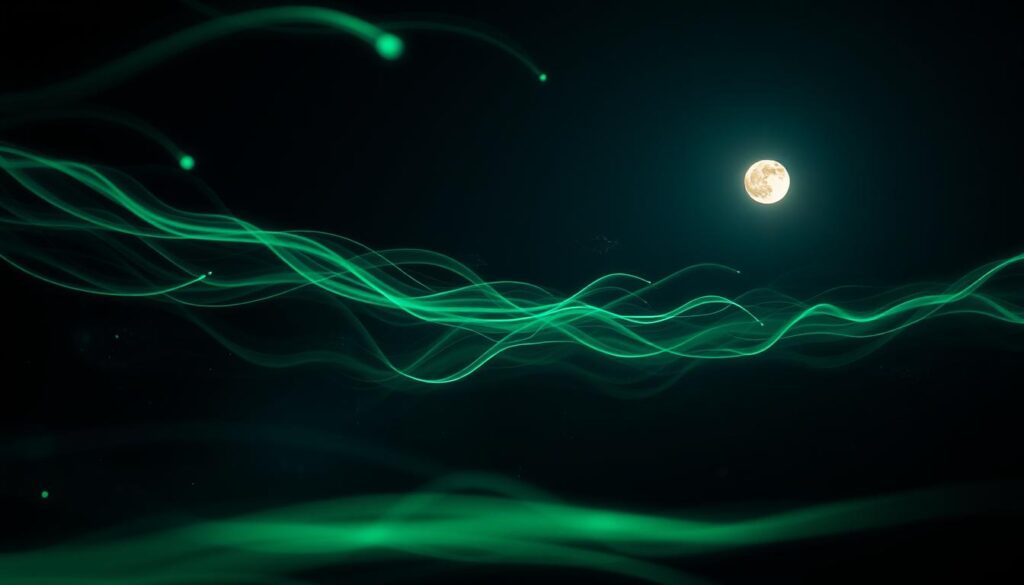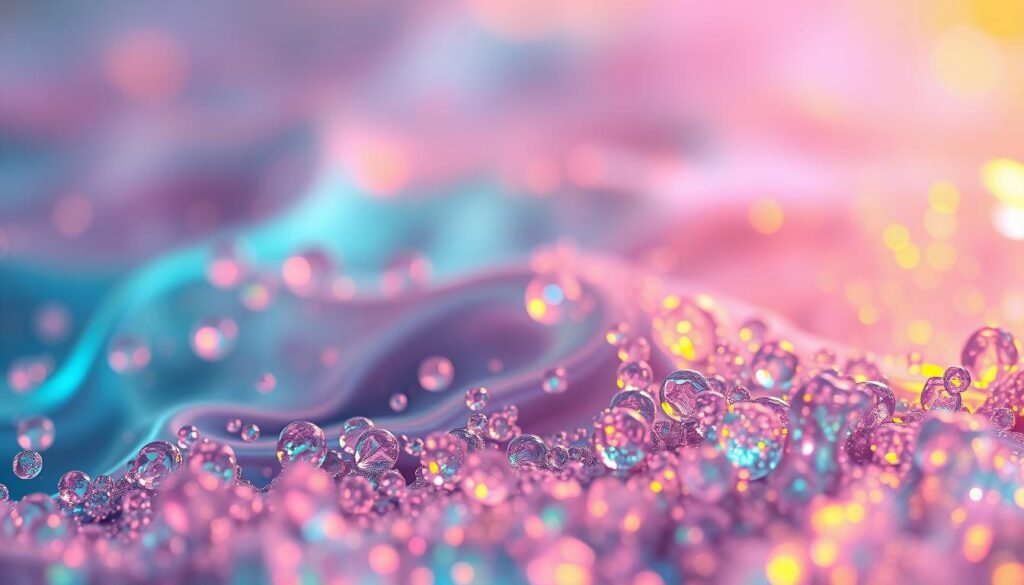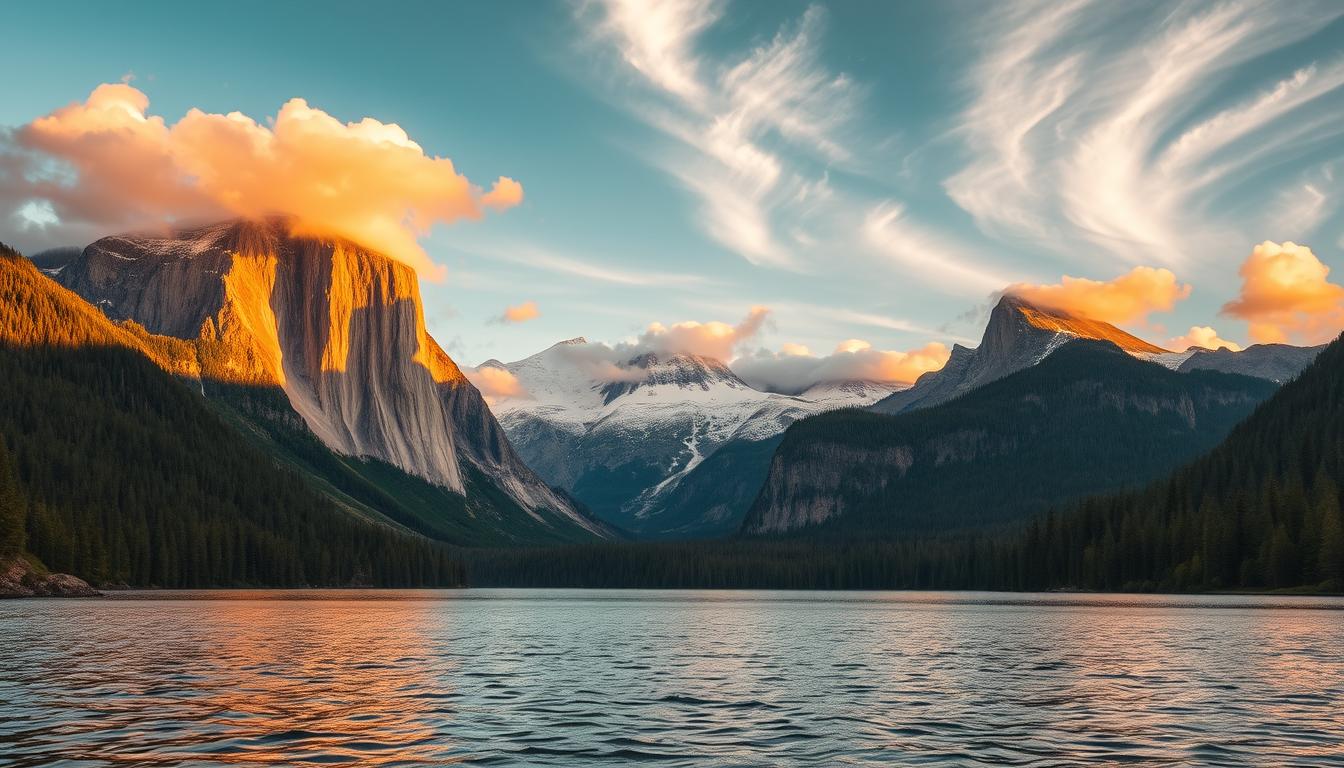Nature is full of amazing color changes. From autumn leaves to color-changing animals, it’s a world of colors. The science behind these changes is really interesting.
In this article, we’ll explore the stunning color transformations in nature. We’ll look at the science behind them. We aim to educate and inspire you about the amazing world of natural color transformations.

Introduction to Natural Color Transformations
Natural color transformations are key to understanding nature. They show the diversity and complexity of our world. By learning about them, we can appreciate nature more.
Key Takeaways
- Nature is full of stunning color transformations that occur in natural wonders and color-changing animals.
- The science behind natural color transformations is fascinating and complex.
- Understanding the different types of natural color transformations can help us appreciate the beauty of nature.
- Natural color transformations occur in a variety of forms, including changes in color, texture, and pattern.
- The study of natural color transformations can help us gain a deeper understanding of the natural world and our place within it.
- Natural color transformations are an essential part of the natural world and play a crucial role in the survival and adaptation of many species.
Understanding Natural Wonders That Change Color
Natural color changes are truly amazing. They can be seen in leaves changing colors and animals blending in. The science behind these changes is complex. It involves molecular structure, environmental conditions, and how animals adapt over time.
There are many types of color changes in nature. These include seasonal changes, camouflage, and communication. For instance, some animals change color to hide. Others use color to warn of danger or to attract a mate. Plants also change color, like when leaves turn in autumn.
- Light exposure
- Temperature
- Humidity
- Genetic adaptations
These factors cause chemical reactions. These reactions change the molecular structure of pigments. This leads to the beautiful color changes we see in nature.
The Magic of Chameleons: Masters of Color Adaptation
Chameleons are famous for their amazing color-changing ability. They use this skill to communicate, keep warm, and hide from danger. Their bodies have special cells called chromatophores that change color by reflecting light.
Chameleons can change color fast, in just seconds. This is key for their survival. It helps them hide, attract mates, and show aggression. Their color-changing tricks make them stand out in the animal world.
Several things affect a chameleon’s color change. These include:
- Light and temperature
- Emotional state
- Surroundings and environment
These factors can make a chameleon change color. This helps it fit in and survive. Chameleons’ color-changing skills are a cool example of how animals adapt.
In short, chameleons’ magic is in their color-changing ability. This makes them one of the most interesting animals. Their skill in blending in has earned them the title of masters of disguise.
Seasonal Color Changes in Nature
Nature’s colors change with the seasons, creating a stunning display. As the earth turns, seasonal color changes happen, making the world colorful. Summer’s warmth and winter’s cold each add their own beauty, with autumn leaves being a highlight.
In autumn, tree leaves change from green to colors like orange, yellow, and red. This is because less chlorophyll is in the leaves, letting other pigments show. In the arctic, arctic animals turn white to hide in the snow.
- Changes in temperature and daylight hours
- Adaptation of plants and animals to their environment
- Transformation of colors in response to environmental factors
These factors make nature’s beauty always changing. Each season is a new and exciting experience.
Ocean’s Color-Changing Creatures
The ocean is full of marine life that can change color. This helps them communicate, hide, and attract prey. Color-changing fish are a great example. They can change color to blend in or signal to other fish.
Special cells in their skin called chromatophores make this possible. These cells contain pigments that reflect light in different ways.
Some ocean creatures even change color to show emotions or respond to their environment. For instance, cuttlefish turn red when they feel threatened or excited. Squid change color to talk to other squid.
These amazing abilities have helped marine life survive in the ocean’s diverse and challenging places.
Here are some examples of ocean creatures that can change color:
- Cuttlefish: can change color to blend in with their surroundings or express emotions
- Squid: can change color to communicate with other squid or hide from predators
- Octopus: can change color to camouflage themselves or signal to other octopuses
- Color-changing fish: can alter their hue to blend in with their surroundings or attract prey
Many other ocean creatures can change color too. This includes corals, jellyfish, and sea turtles. The ocean’s incredible diversity of marine life shows its complexity and beauty. It’s why we must protect these ecosystems for the future.
Temperature-Reactive Natural Phenomena
Temperature is key in shaping our world, affecting many fascinating phenomena. It changes the colors of hot springs and shapes geothermal features. These temperature-reactive events are vital parts of our planet’s beauty.
Hot springs are a prime example. They form when groundwater heats up from geothermal energy. These sights are stunning and home to many microorganisms that love warm temperatures.
Some key traits of these phenomena include:
- Color changes with temperature shifts
- Unique geological shapes, like geothermal features
- Support for a variety of microorganisms and ecosystems
These events are not just captivating to watch. They also help us understand our world and its wonders.
Bioluminescent Wonders Around the World
Bioluminescence is a fascinating phenomenon found worldwide. It includes glowing plants and bioluminescent creatures. This ability to produce light has amazed humans for centuries.
It serves many purposes in nature, like communication and defense. It also helps attract prey.
In the ocean, creatures like fish and squid use light to communicate and hide from predators. On land, glowing plants and fungi emit a soft glow. These wonders are not just beautiful but also crucial to their ecosystems.

- Fireflies, found in warm and temperate regions around the world
- Glowworms, found in caves and forests in New Zealand and Australia
- Bioluminescent fish, found in the deep waters of the ocean
These creatures are just a few examples of bioluminescent wonders worldwide. By studying and appreciating these wonders, we learn about bioluminescence’s importance. It shapes our planet’s ecosystems.
Rare Color-Changing Minerals and Crystals
Color-changing minerals have always amazed people. They change color when their environment changes. Alexandrite is a famous gemstone that changes color with the light. It looks blue-green in daylight and red-purple in incandescent light.
Other stones like benitoite and charoite also change color. Benitoite turns from blue to white, and charoite changes from purple to pink. These minerals are not just beautiful but also tell us about the Earth’s history.
- Unique crystal structures that allow for color change
- Rarity, making them highly valuable and sought after
- Ability to change color in response to changes in lighting or temperature
Other rare gemstones like tanzanite and padparadscha also change color. These stones are loved for their beauty and rarity. They are often used in luxury jewelry.
Scientists are still learning about color-changing minerals. They study these minerals to understand how they change color. This research helps us learn about the Earth’s history and might lead to new technologies.
Chemical Reactions in Nature’s Palette
Nature’s palette is full of vibrant colors and patterns. These are often created by chemical reactions. These reactions are key in the natural world, leading to the stunning color changes we see.
From the oxidation of metals to the polymerization of organic compounds, chemical reactions are behind the diverse colors and patterns. They make nature’s beauty possible.
In nature, color-changing reactions happen often. For example, the colors of leaves changing in autumn are due to chemical reactions. As days get shorter and cooler, trees prepare for winter by slowing down their food-making process.
This slowdown in chlorophyll production lets hidden pigments show, creating autumn colors. It’s a beautiful sight.
Some important chemical reactions in nature include:
- Oxidation reactions, which occur when a substance combines with oxygen
- Polymerization reactions, which involve the combination of molecules to form a new compound
- Hydrolysis reactions, which occur when a substance reacts with water

Understanding chemical reactions helps us appreciate nature’s beauty and complexity. Recognizing the role of color-changing reactions in our environment deepens our appreciation for nature’s intricate web of chemical reactions.
Light-Influenced Natural Color Changes
Light greatly affects the natural world, changing colors and patterns. From birds’ shimmering feathers to flowers’ vibrant petals, these changes are fascinating. Iridescence, a property that reflects light, plays a big role in these shifts.
Birds and insects show off light-influenced color changes beautifully. A peacock’s feathers or a butterfly’s wings reflect light in amazing ways. This creates colors that seem to move and change with the light’s angle.
Light also changes the colors of sun-responsive plants. These plants adjust their colors based on light to grow and survive better. For instance, some plants turn red or purple with more sunlight. This shows how light changes colors in nature.
Here are some sun-responsive plants:
- Flowers that change color with sunlight, like the morning glory
- Leaves that change color to help with photosynthesis, like the prayer plant
- Stems that change color to attract pollinators, like the honeysuckle
Environmental Factors Affecting Natural Color Changes
Environmental factors greatly shape our world and impact natural color changes. Climate change is a big factor, changing ecosystems and how plants and animals adapt.
Important environmental factors include:
- Pollution: It can change the color of plants, animals, and their surroundings.
- Habitat destruction: It leads to color changes in plants, animals, and their homes.
- Temperature and weather patterns: These changes affect the color of plants, animals, and their environments.
These factors significantly influence natural color changes. For instance, climate change makes plants and animals change color due to temperature and weather changes. This affects entire ecosystems, causing changes in natural color changes we see.
To understand environmental factors on natural color changes, we must study plants, animals, and their environments. This helps us appreciate the complex web of life in nature. It shows how environmental factors impact natural color changes we see.
Nature is full of mysteries, not just with breathtaking color-changing wonders but also with uninhabited islands.
Conclusion: Preserving Nature’s Color-Changing Spectacles
Nature’s color changes are truly amazing. From autumn leaves to Arctic animals, they show how adaptable our planet is. These changes are a sign of nature’s strength and beauty.
But, these wonders are at risk. Human actions like destroying habitats and polluting harm them. Groups like the World Wildlife Fund and the Nature Conservancy are fighting to save them. They work hard to protect nature and teach us to live sustainably.
We can help by supporting these groups and living greener. We should also push for laws that protect nature. Together, we can keep these wonders alive for future generations.
FAQ
What is the science behind color changes in nature?
Color changes in nature come from many things. This includes how molecules work, how light interacts, and what’s around them. These changes help plants and animals adapt, change with the seasons, and react to their environment.
What are the different types of natural color transformations?
Nature shows many color changes. For example, leaves change color with the seasons, animals blend into their surroundings, and flowers go through color cycles. These changes help with communication, keeping warm, hiding from predators, and more.
Why do animals and plants change colors?
Animals and plants change colors for many reasons. They use color to talk to each other, stay cool, hide, and adapt to their surroundings. These color changes can be signals, defenses, or responses to their environment.
How do chameleons master color adaptation?
Chameleons are famous for changing color. They have special cells called chromatophores that let them change color to match their surroundings. This helps them communicate, regulate their temperature, and hide.
What are the seasonal color changes observed in nature?
Nature shows many seasonal color changes. For example, leaves turn colors in autumn, Arctic animals camouflage in winter, and flowers change colors with the seasons. These changes happen because of things like temperature, light, and water.
What color-changing creatures are found in the ocean?
The ocean is full of creatures that can change color. This includes fish, squid, corals, and jellyfish. They change color to talk to each other, hide, and attract food.
How do temperature-reactive natural phenomena exhibit color changes?
Temperature can make some natural things change color. For example, hot springs, weather features, and plants that change color with temperature. These color changes happen because of chemical reactions and how they adapt to their surroundings.
What are the bioluminescent wonders found around the world?
Bioluminescence, or the ability to make light, is seen in many places. This includes glowing plants, fungi, and sea creatures like fish and squid. They use light for communication, defense, and to attract prey.
What are the rare color-changing minerals and crystals?
Some minerals and crystals, like alexandrite, can change color. These color changes happen because of their complex structures and how they react to light.
How do chemical reactions contribute to natural color changes?
Chemical reactions are key to many natural color changes. They can involve metals oxidizing, organic compounds polymerizing, and more. These reactions create the vibrant colors and patterns we see in nature.
How is light responsible for natural color changes?
Light plays a big role in many natural color changes. For example, the shine on bird feathers and insect wings, and how some plants react to sunlight. These color changes happen because of how light interacts with nature’s structures and pigments.
How do environmental factors affect natural color changes?
Things like climate change, pollution, and habitat loss can change nature’s colors. These changes can upset the balance of ecosystems and alter the colors and adaptations of plants and animals.
